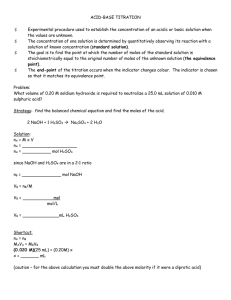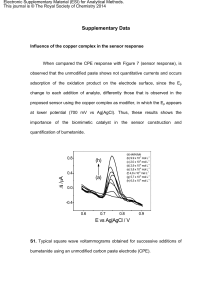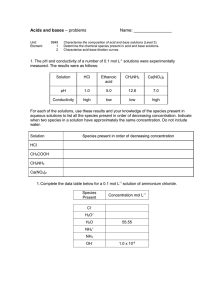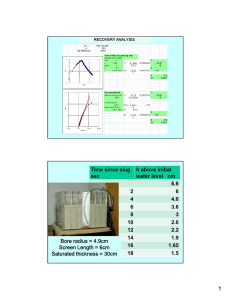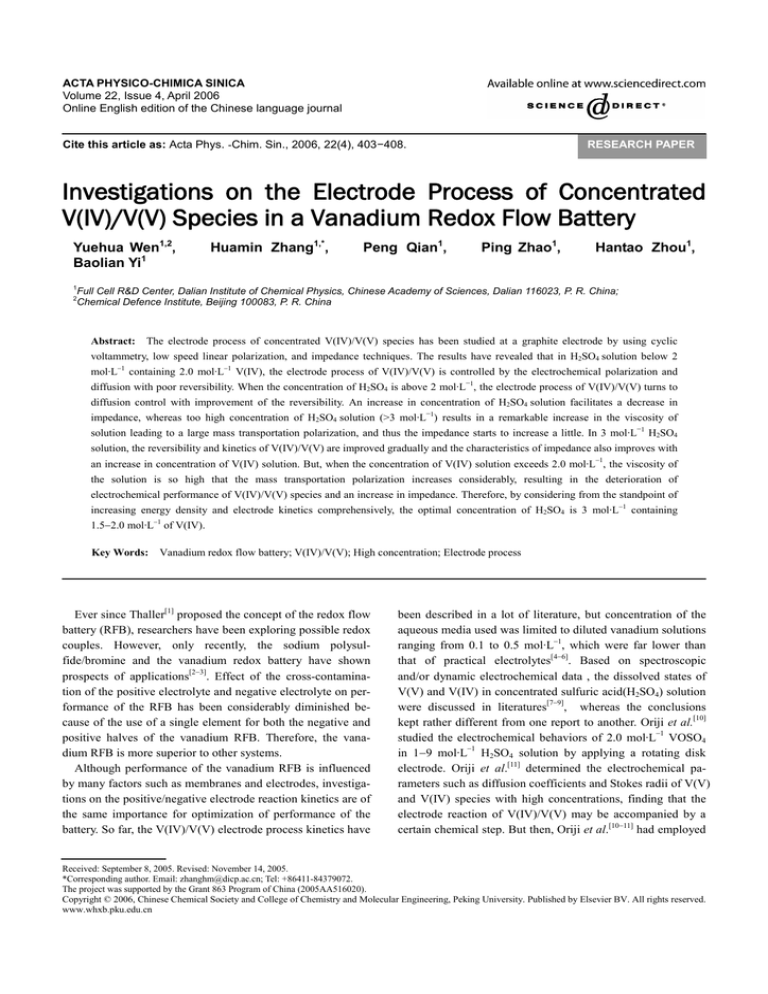
ACTA PHYSICO-CHIMICA SINICA
Volume 22, Issue 4, April 2006
Online English edition of the Chinese language journal
Cite this article as: Acta Phys. -Chim. Sin., 2006, 22(4), 403−408.
RESEARCH PAPER
Investigations on the Electrode Process of Concentrated
V(IV)/V(V) Species in a Vanadium Redox Flow Battery
Yuehua Wen1,2,
Baolian Yi1
Huamin Zhang1,*,
Peng Qian1,
Ping Zhao1,
Hantao Zhou1,
1
Full Cell R&D Center, Dalian Institute of Chemical Physics, Chinese Academy of Sciences, Dalian 116023, P. R. China;
Chemical Defence Institute, Beijing 100083, P. R. China
2
Abstract:
The electrode process of concentrated V(IV)/V(V) species has been studied at a graphite electrode by using cyclic
voltammetry, low speed linear polarization, and impedance techniques. The results have revealed that in H2SO4 solution below 2
mol·L-1 containing 2.0 mol·L-1 V(IV), the electrode process of V(IV)/V(V) is controlled by the electrochemical polarization and
-
diffusion with poor reversibility. When the concentration of H2SO4 is above 2 mol·L 1, the electrode process of V(IV)/V(V) turns to
diffusion control with improvement of the reversibility. An increase in concentration of H2SO4 solution facilitates a decrease in
-
impedance, whereas too high concentration of H2SO4 solution (>3 mol·L 1) results in a remarkable increase in the viscosity of
-1
solution leading to a large mass transportation polarization, and thus the impedance starts to increase a little. In 3 mol·L
H2SO4
solution, the reversibility and kinetics of V(IV)/V(V) are improved gradually and the characteristics of impedance also improves with
an increase in concentration of V(IV) solution. But, when the concentration of V(IV) solution exceeds 2.0 mol·L-1, the viscosity of
the solution is so high that the mass transportation polarization increases considerably, resulting in the deterioration of
electrochemical performance of V(IV)/V(V) species and an increase in impedance. Therefore, by considering from the standpoint of
increasing energy density and electrode kinetics comprehensively, the optimal concentration of H2SO4 is 3 mol·L-1 containing
1.5-2.0 mol·L-1 of V(IV).
Key Words:
Vanadium redox flow battery; V(IV)/V(V); High concentration; Electrode process
Ever since Thaller[1] proposed the concept of the redox flow
battery (RFB), researchers have been exploring possible redox
couples. However, only recently, the sodium polysulfide/bromine and the vanadium redox battery have shown
prospects of applications[2-3]. Effect of the cross-contamination of the positive electrolyte and negative electrolyte on performance of the RFB has been considerably diminished because of the use of a single element for both the negative and
positive halves of the vanadium RFB. Therefore, the vanadium RFB is more superior to other systems.
Although performance of the vanadium RFB is influenced
by many factors such as membranes and electrodes, investigations on the positive/negative electrode reaction kinetics are of
the same importance for optimization of performance of the
battery. So far, the V(IV)/V(V) electrode process kinetics have
been described in a lot of literature, but concentration of the
aqueous media used was limited to diluted vanadium solutions
ranging from 0.1 to 0.5 mol·L-1, which were far lower than
that of practical electrolytes[4-6]. Based on spectroscopic
and/or dynamic electrochemical data , the dissolved states of
V(V) and V(IV) in concentrated sulfuric acid(H2SO4) solution
were discussed in literatures[7-9], whereas the conclusions
kept rather different from one report to another. Oriji et al.[10]
studied the electrochemical behaviors of 2.0 mol·L-1 VOSO4
in 1-9 mol·L-1 H2SO4 solution by applying a rotating disk
electrode. Oriji et al.[11] determined the electrochemical parameters such as diffusion coefficients and Stokes radii of V(V)
and V(IV) species with high concentrations, finding that the
electrode reaction of V(IV)/V(V) may be accompanied by a
certain chemical step. But then, Oriji et al.[10-11] had employed
Received: September 8, 2005. Revised: November 14, 2005.
*Corresponding author. Email: zhanghm@dicp.ac.cn; Tel: +86411-84379072.
The project was supported by the Grant 863 Program of China (2005AA516020).
Copyright © 2006, Chinese Chemical Society and College of Chemistry and Molecular Engineering, Peking University. Published by Elsevier BV. All rights reserved.
www.whxb.pku.edu.cn
WEN Yuehua et al. / Acta Physico-Chimica Sinica, 2006, 22(4): 403-408
a platinum electrode and a glassy carbon electrode, while
practical electrodes are graphite and porous carbon felts. In
addition, the concentration of a vanadium aqueous solution
and H2SO4 as a supporting electrolyte had not been optimized.
In the present study , the electrode process kinetics of concentrated V(IV)/V(V) at a graphitic electrode have been studied by cyclic voltammetry, linear sweep voltammetry at a low
scan rate, and impedance measurements to obtain the optimal
concentration of V(IV)-H2SO4 solution used in the vanadium
RFB.
1
1.1
Experimental
Preparation of V(IV)-H2SO4 solution
VOSO4·nH2O (Shanghai Lvyuan Chemicals, n=3.0 according to thermogravimetric analysis, the purity is ≥97.9%.) was
dissolved in 1-4 mol· L-1 H2SO4 to give a V(IV) solution.
1.2
Pretreatment of electrodes
A graphitic rod (Shanghai Xinxia carbon Co Ltd) was employed as a working electrode. Prior to determination, the
electrode surface was polished with a 1000-grit polishing paper, and then the electrode was sonicated for 10 min in water,
followed by air-dry.
1.3
2.1 Effect of H2SO4 concentration on the V(IV) / V(V) electrode reaction
The concentration of V(IV) solution commonly used in the
vanadium flow battery is 2.0 mol·L-1 [5-6]. Fig.1 shows cyclic
voltammograms of 2.0 mol· L-1 VOSO4 in 1-4 mol·L-1 H2SO4
solution. The potential differences(∆Vp) and the ratios (Ipa/ Ipc )
of the anodic peak current to the cathodic peak current obtained from Fig.1 are listed in Table 1. As can be seen from
Table 1, when applying 1 mol·L-1 H2SO4, the anodic peak current is far higher than the cathodic peak current, leading to the
Ipa/Ipc beyond 1.8. It can be deduced from the electrode reaction expression (1) that 1.0 mol V(V) can not be reduced
unless 2.0 mol H+ exists in the solution. However, when 1
mol·L-1 H2SO4 is used, the n(H+) is just the theoretic value of
H+ needed for the reduction reaction of V(V). It suggests that
practical requirements for the reduction reaction of V(V)
would not be met. And hence the anodic peak current is much
larger than the cathodic peak with a relatively larger potential
difference and providing poor reversibility for the couple.
VO2++2H++e-=VO2++H2O
(1)
As the concentration of H2SO4 increases, the peak potential
difference as well as Ipa/ Ipc decreases and the Ipa/ Ipc is gradually close to 1 with an improvement in reversibility of the
Apparatus and equipment
A Ubbelohde-type capillary viscometer; A model 600B
electrochemical workstation (Shanghai CH Instruments Co.);
An EG&G electrochemical workstation (Princeton Corporation, USA) including a 273A potentiostat and a 1025 frequency response analyzer.
1.4
Measurement procedures
The viscosity of the solution was obtained as follows: a
volume of liquid was taken to flow through the capillary viscometer from a fixed height of the liquid surface in a thermostat bath of (20±2)℃, and the flowing time was recorded,
multiplying with the correcting constant coefficient (0.04112
mm2·s-2) to give the viscosity .
A graphite rod (area=0.103 cm2) and a saturated calomel
reference electrode(SCE) were employed as the working and
the reference electrodes, respectively. Subsequently, a threesystem was built by using a graphite plate with a large surface
area as the counter electrode. The cyclic voltammetry and linear polarization plots of V(IV)-H2SO4 solution with different
concentrations were determined by applying the model 600B
electrochemical workstation. In the same cell with three electrodes, the impedance measurements of V(IV)-H2SO4 solution
with different concentrations were carried out with an EG&G
electrochemical workstation at frequency from 1×105 Hz to
0.1 Hz with an amplitude of ±5 mV.
2
Results and discussion
Fig.1
Cyclic voltammograms of a stationary graphite electrode
in 1-4 mol·L-1 H2SO4 solution containing 2.0 mol·L-1 V(IV)
scan rate=50 mV·s-1, c(H2SO4)/(mol·L-1) : 1) 1; 2) 2 ; 3) 3 ; 4) 4
Table 1
Cyclic voltammogram data of 2.0 mol·L-1
VOSO4 on a graphite electrode in 1- 4 mol·L-1 H2SO4 solution
c(H2SO4)/(mol·L-1)
∆Vp[a] / V
Ipa /Ipc[b]
1
0.386
1.817
2
0.249
1.224
3
0.185
1.121
4
0.212
1.032
[a] ∆Vp means the difference between the anodic potential and the cathodic potential.
[b] Ipa /Ipc means the ratio of the anodic peak current to the cathodic peak
current.
WEN Yuehua et al. / Acta Physico-Chimica Sinica, 2006, 22(4): 403-408
couple. When the concentration of H2SO4 is up to 3 mol· L-1,
the potential difference is the lowest with the Ipa/Ipc close to 1
and the peak current starts to decrease when using H2SO4
higher than 4 mol·L-1. This is due to the fact that when the
concentrations of H2SO4 are 1, 2, 3, and 4 mol·L-1, the corresponding viscosities of the V(IV)-H2SO4 solutions are 7.895,
10.07, 10.65, and 12.62 mm2·S-1, indicating that when the
concentration of H2SO4 is too high(>3 mol·L-1), a relatively
remarkable increase in viscosity can be observed and effect of
mass transportation resistance on the electrode reaction becomes larger, resulting in a decrease in the peak current.
Therefore, in the case of 2.0 mol·L-1 V(IV) solution applied,
it is favorable to employ 3 mol·L-1 H2SO4 as a supporting
electrolyte.
To explain the relationship between the concentration of
H2SO4 and the V(IV)/V(V) electrode process, an overpotential
of less than 25 mV is applied on the equilibrium potential of
V(IV) / V(V) . Also, a polarization resistance is determined by
applying the sweep voltammetry at a low scan rate of 0.5
mV·s-1. Fig.2 presents the typical linear polarization plot of
2.0 mol·L-1 VOSO4+1 mol·L-1 H2SO4 solution.
In the potential range near the equilibrium electrode potential (≤25 mV), the relationship between current and overpotential is linear. The ratio of overpotential to current is called
the polarization resistance (Rp), namely Rp =ΔE/ΔI[12]. The
polarization resistance (Rp) and related kinetic parameters
calculated from the linear polarization plots of 2.0 mol·L-1
VOSO4 in 1-4 mol·L-1 H2SO4 are listed in Table 2. The exchange current density (I0) and reaction rate constant (k0) were
calculated using the following expressions[12] , where c is the
concentration of the V(IV)-solution:
I0=[RT/nF]/Rp
(2)
k0 = I0 /nFc
(3)
As can be seen from Table 2, when the concentration of
H2SO4 is 3 mol· L-1, the polarization resistance of V(IV)/V(V)
is the smallest with a high exchange current density and rate
constant, which is consistent with the results of above cyclic
voltammogram experiments. But, the rate constant data of
Table 2
mol·L-1 VOSO4 in 1-4 mol·L-1 H2SO4
c(H2SO4)/(mol·L-1)
Rp / Ω
104 I0 /(A·cm-2)
106 k0 /(cm·s-1)
1
236
1.09
0.565
2
163
1.57
0.813
3
128
2.01
1.04
4
186
1.38
0.715
scan rate: 0.5 mV·s-1
V(IV)/V(V) obtained are two orders lower than those reported by previous workers [6]. This difference may be due to
that fact that the experiments reported here were carried out
at extremely low overpotential limits[12].
2.2 V(IV)/V(V) electrode reaction- V(IV) concentration relationships
Using 3 mol·L-1 H2SO4 as a supporting electrolyte, cyclic
voltammograms of a stationary graphite electrode in 3 mol·L-1
H2SO4 solution containing 0.3-3.0 mol·L-1 V(IV) is presented
in Fig.3. It can be seen that the cathodic peak current of 0.3
mol·L-1 VOSO4 solution is lower than the anodic peak current.
Fig.3
Fig.2
Typical linear polarization plot of 2.0 mol·L-1 VOSO4+
1 mol·L-1H2SO4 solution
Polarization resistance (Rp), exchange-current density
(I0), and rate constant (k0) obtained by linear polarization of 2.0
Cyclic voltammograms of a stationary graphite electrode
in 3 mol·L-1 H2SO4 solution containing 0.3-3.0 mol·L-1 V(IV)
scan rate=50 mV·s-1
-1
c(VOSO4)/(mol·L ): a)0.3; b)0.5; c)1.0 ; d)1.5; e)2.0 ; f)) 2.5; g ) 3.0
WEN Yuehua et al. / Acta Physico-Chimica Sinica, 2006, 22(4): 403-408
With an increase in concentration of VOSO4, the cathodic
peak current tends to be close to the anodic peak current, resulting in an improvement of reversibility. The peak current is
enhanced sharply with the concentration of VOSO4 increasing.
When the concentration of VOSO4 is 1.5-2.0 mol·L-1, the
peak current reaches the highest, whereas a further increase in
the concentration of VOSO4 leads to a decrease in the peak
current, especially when the concentration of VOSO4 is up to
3.0 mol·L-1. It is seen from Fig.4 that the viscosity of the
VOSO4 solution above 2.0 mol·L-1 increases considerably,
leading to a tendency to increase the effect of mass transportation resistance.
Cyclic voltammogram data obtained from Fig.3 are listed
in Table 3. It can be seen that Ipa/Ipc is as high as 1.547 at the
VOSO4 concentration of 0.3 mol·L-1. This is possibly because
V(V) ions obtained by oxidizing V(IV) ions are more likely
to diffuse into the bulk solution in low concentration of
VOSO4 aqueous solution, resulting in a reduction of V(V)
ions on electrode surfaces. Thus, the anodic peak current is
much higher than the cathodic peak current. As the concentration of VOSO4 increases, the Ipa/Ipc is reduced. When the
concentration of VOSO4 exceeds 1.0 mol·L-1, Ipa/Ipc is stabilized at more or less than 1.1. Also, the lowest potential difference (∆Vp) can be acquired with VOSO4 of 1.5 mol·L-1.
When the concentration of VOSO4 increases to be above 2.5
mol·L-1, ∆ Vp rapidly becomes larger, indicating the poor reversibility. The reason is that a remarkable increase in the
viscosity of solution with its concentration leads to high mass
transportation resistance and a decrease in reversibility of the
system as shown in Fig.4.
The polarization resistance (Rp) of the electrode reaction in
3 mol·L-1 H2SO4 containing 0.3-3.0 mol·L-1 VOSO4 obtained
from the linear polarization plot at a low sweep rate of 0.5
mV·s-1 is shown in Fig.5. Two observations can be made
from the data. Firstly, the polarization resistance increases
sharply at concentration of VOSO4 higher than 2.0 mol· L-1 or
lower than 0.5 mol·L-1. Secondly, the polarization resistance
Fig.4
Dependence of the viscosity of the V(IV)-3 mol·L-1
H2SO4 solution on the VOSO4 concentration at 20 ℃
Table 3
Cyclic voltammogram data of 0.3-3.0 mol·L-1
VOSO4 on a graphite electrode in 3 mol·L-1 H2SO4 solution
c(VOSO4)/(mol·L-1)
∆Vp[a] / V
Ipa / Ipc[b]
0.3
0.182
1.547
0.5
0.163
1.350
1.0
0.157
1.190
1.5
0.124
1.179
2.0
0.149
1.121
2.5
0.265
1.124
3.0
0.251
1.094
[a] ∆Vp means the difference between the anodic potential and the cathodic potential.
[b] Ipa/Ipc means the ratio of the anodic peak current to the cathodic peak
current.
is the lowest when the concentration of VOSO4 is 1.0 mol·L-1
with a slight increase when the concentration of VOSO4 is
between 1.5 and 2 .0 mol·L-1.
2.3 Studies on the electrode process of concentrated
V(IV) /V(V) by AC impedance
In the above three-electrode system, the electrode process
of V(IV)/V(V) at high concentration is further investigated
and verified below.
Fig.6 presents the AC impedance plot for 2.0 mol·L-1
VOSO4 in 1-4 mol·L-1 H2SO4. It can be seen that the electrochemical polarization loop at high frequency and a slope
line of 45° at medium or low frequency are observed when
the H2SO4 concentration is 1 mol·L-1, showing a high impedance. It indicates that the electrode process is controlled
by both diffusion and electrochemical polarization. With the
increase in concentration of H2SO4, the electrode process of
the system turns to be controlled by diffusion with the lowest resistance when applying the 3 mol·L-1 H2SO4.
Fig.5
Polarization resistance vs the VOSO4 concentration
plots for the V(IV) -3 mol·L-1 H2SO4 solution
WEN Yuehua et al. / Acta Physico-Chimica Sinica, 2006, 22(4): 403-408
Fig.6
AC impedance spectra for 2.0 mol·L-1 VOSO4 in1-4 mol·L-1H2SO4
From the above analysis, the equivalent circuit of the AC
impedance spectra is shown in Fig.7, where RL stands for
Ohmic resistance, the plat double-layer capacitance (Cdl) is
connected in parallel with the reaction resistance(Rf) to
stand for the half-circle of electrochemical polarization at
high frequency, Wo stands for the Warburg diffusion resistance. Data obtained by simulating various components of
the equivalent circuit are listed in Table 4. It can be seen that
for 2.0 mol·L-1 VOSO4 in 1 mol·L-1H2SO4, the Rf is the
highest due to a small n(H+) and the RL is the lowest when
using 3 mol·L-1 H2SO4. The RL depends mainly on the
conductivity of electrode materials and electrolyte and contact resistance, wherein the RL directly reflects the differences from the conductivity of electrolytes. An increase in
concentration of H2SO4 facilitates an improvement of the
solution conductivity. However, as mentioned above, there
is a sharp increase in the viscosity of solution when the
concentration of H2SO4 is up to 4 mol·L-1, so that the RL for
the V(IV)-solution in 4 mol·L-1 H2SO4 is higher than that for
the V(IV)-solution in 3 mol·L-1 H2SO4. It further indicates
from the impedance investigation that for the 2.0 mol·L-1
V(IV)-solution, 3 mol·L-1 H2SO4 is favorable to be used as a
supporting electrolyte.
Fig.8 presents the impedance plots for 1.0-3.0 mol·L-1
VOSO4 in 3 mol·L-1 H2SO4. It is shown that the electrode
process for the VOSO4 solution of various concentrations is
Table 4
Equivalent circuit parameters for the AC impedance
spectra of 2.0 mol·L-1 VOSO4 in 1-4 mol·L-1 H2SO4
c(H2SO4)
RL
Rf
(mol·L-1)
Fig.7
Equivalent circuit plot for the AC impedance spectra of
2.0 mol·L-1 VOSO4 in 1-4 mol·L-1 H2SO4
RL: ohmic resistor; Rf: reaction resistor; Cdl: capacitor;
Wo: Warburg resistor
Warburg resistance
Zc
Wo-R
Wo-T
Wo-P
1
8.069
25.85
1.74×10-4
1.98
1.7×10-5
0.22051
2
7.864
1.924
3.55×10-4
204
2.445
0.42337
3
5.554
2.425
0.0224
3.98
0.0130
0.25865
4
7.276
1.001
5.56×10-5
3.76
7.2×10-3
0.26660
RL, Rf are the same as Fig.7; Zc: capacitor resistance. WO-R, WO-T, and
WO-P are three Parameters of the Warburg resistance.
WEN Yuehua et al. / Acta Physico-Chimica Sinica, 2006, 22(4): 403-408
Table 5
Equivalent circuit parameters for the AC impedance
spectra of 1.0-3.0 mol·L-1 VOSO4 in 3 mol·L-1 H2SO4
c (VOSO4)
Warburg resistance
RL
Rf
Zc
(mol·L-1)
Fig.8
AC impedance spectra for 1.0-3.0 mol·L-1 VOSO4 in
-1
3 mol·L H2SO4
controlled by diffusion, whereas the impedance is the
smallest when the concentration of VOSO4 is 2.0 mol·L-1,
slightly larger for 1.5 mol·L-1 VOSO4.
Components parameters of the equivalent circuit obtained
by simulating the impedance plot in Fig.7 are listed in Table
5. It can be seen that as the concentration of VOSO4 is
raised, the RL increases step by step, especially showing a
marked increase for 3.0 mol·L-1 VOSO4. It is because of the
fact that the conductivity of the VOSO4 solution is mainly
dependent on H2SO4 due to existence of V(IV) as a complex
ion with a large diameter. It is known from the above statements that in 3 mol·L-1 H2SO4, the viscosity of the solution
continues to increase as well as the RL with an enhancement
in the concentration of VOSO4. In particular, when the concentration of VOSO4 is up to 3 mol·L-1, the viscosity of the
solution increases considerably as well as the RL. Thus, from
the viewpoint of the electrode process kinetics and giving
attention to the energy density of batteries, the preferable
concentration of VOSO4 ranges from 1.5 to 2.0 mol·L-1.
3
Conclusion
Applying the cyclic voltammetry, linear sweep voltammetry at a low scan rate and impedance technique, the effects of the concentration of V(IV) and H2SO4 on the electrode process were investigated in the range of relatively
high concentration. It is shown that for the V (IV) solution
of 2.0 mol·L-1, when using H2SO4 below 2 mol·L-1 as the
supporting electrolyte, the polarization for the electrode reaction of V(IV)/V(V) is large with a poor reversibility and
the electrode process is controlled by the electrochemical
polarization and diffusion, together. When using H2SO4
above 2 mol·L-1, the reversibility of the V(IV)/V(V) reaction is significantly enhanced and the electrode process is
controlled by diffusion with a decrease in impedance as the
concentration of H2SO4 is raised. Whereas, when the concentration of H2SO4 is up to 4 mol·L-1, the high viscosity of
Wo-R
Wo-T
Wo-P
0.02598
0.39862
1.0
3.826 0.4876 2.4785×10-4 2.132
1.5
3.979 1.380
0.022652
174.9
12.12
0.53583
2.0
5.554 2.425
0.022400
3.980
0.01300
0.25865
3.0
14.38 1.537
0.055498
0.05599 1.159×10-6 0.27779
RL, Rf , and Zc are the same as Table 4.
solution and the high mass transportation resistance result in
a slight increase in impedance. In 3 mol·L-1 H2SO4, with the
concentration of V(IV) increasing, the reversibility and kinetics of the system is improved with a decrease in impedance. However, when the concentration of V(IV) is beyond
2.0 mol·L-1, the viscosity of solution is so high that the mass
transportation resistance would increase remarkably, leading
to a deterioration in the electrochemical performance of
V(IV)/V(V) with an increase in impedance. Therefore, considering comprehensively two factors of the electrode reaction kinetics and energy density of batteries, the optimal
concentration of the V(IV) solution is 1.5-2.0 mol·L-1 in 3
mol·L-1 H2SO4.
References
1 Thaller, L. H. Electrically rechargeable redox flow cell. U.S.
Patent, 3996064. 1974
2 Bartolozzi, M. J. Power Sources, 1989, 27: 219
3 Fabjan, C.; Garche, J.; Harrer, B.
Electrochimica Acta, 2001,
47: 825
4 Gattrell, M.; Park, J.; Dougall, B. M.
J. Electrochem. Soc., 2004,
151: A123
5 Zhong, S.; Skyllas-Kazacos, M. J. Power Sources, 1992, 39:1
6 Sum, E.; Rychcik, M.; Skyllas-Kazacos, M. J. Power Sources,
1985, 16: 85
7 Kausar, N.; Howe, R.; Skyllas-Kazacos, M. J. Appl. Electrochem., 2001, 31: 1327
8 Madic, C.; Begun, G. M.; Hahn, R. L.; Launay, J. P.; Thiessen, W.
E. Inorg. Chem., 1984, 23: 469
9 Rahman, F.; Skayllas-Kazacos, M. J. Power Sources, 1998, 72:
105
10 Oriji, G.; Katayama, Y.; Miura, T. Electrochimica Acta, 2004, 49:
3091
11 Oriji, G.; Katayama, Y.; Miura, T. J. Power Sources, 2005, 139:
321
12 Mathur, P. B.; Rajagopalan, C. S.; Bhatt, D. P. J. Power Sources,
1987, 19: 26



